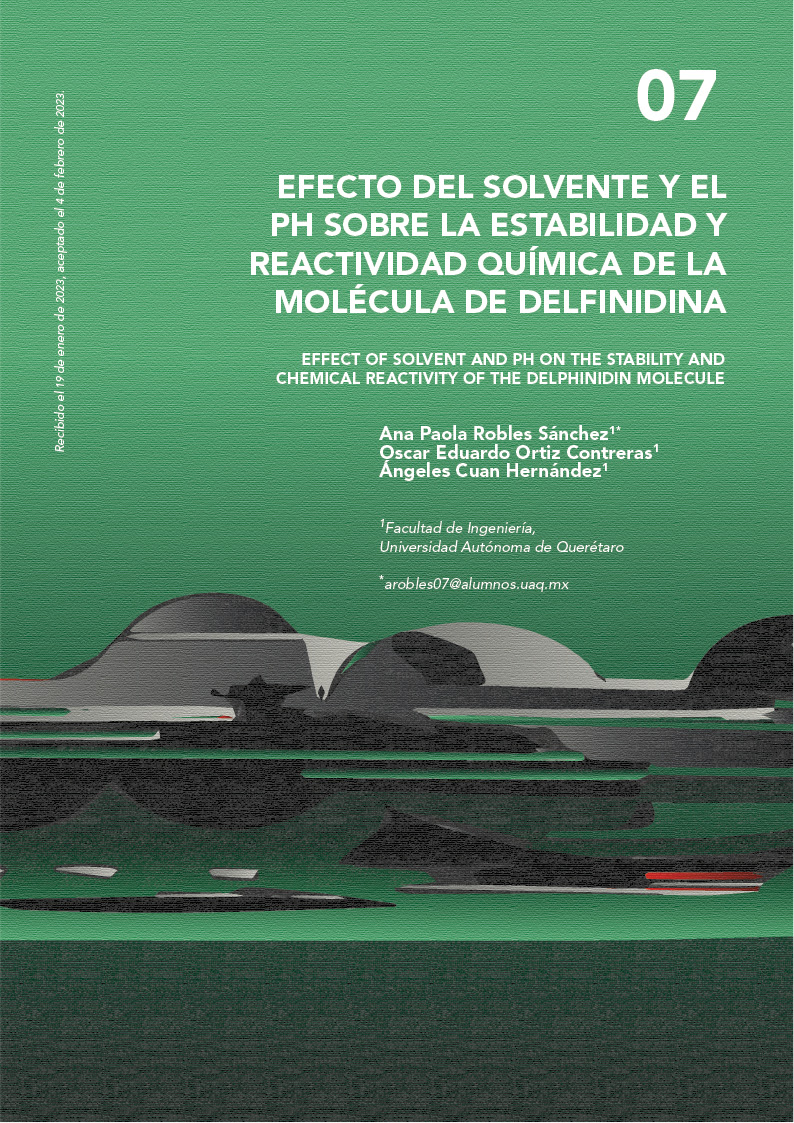Resumen
Se presenta el estudio de la estabilidad en diferentes disolventes y su efecto en la reactividad química para la molécula de delfinidina, utilizando como herramienta el modelado molecular. El modelado estructural de la delfinidina en los diferentes disolventes (agua, metanol, etanol y acetona) se realizó en base a las estructuras predominantes de la delfinidina de acuerdo a los pH (1, 4.5, 5.5 y 7). Los estudios mecánico cuánticos se realizaron utilizando la teoría funcional de la densidad (DFT) con un nivel B3LYP y un conjunto base 6-11+g (d,p). Se obtuvieron las energías de solvatación de la molécula de delfinidina, encontrando que en metanol es donde mejor se disuelve la molécula. Además, se obtuvieron los índices de reactividad química para la molécula por efecto de disolvente, encontrando que cuando se encuentra en agua como disolvente, adquiere una menor dureza, volviéndola más susceptible, esto es, más reactiva. Los resultados también mostraron que a pH < 2 utilizando metanol como disolvente, el átomo de hidrógeno del grupo hidroxilo unido al carbono 4´ es el más propenso a donar hidrógenos.
Referencias
S. K. Panchal, O. D. John, M. L. Mathai, and L. Brown, “Anthocyanins in chronic diseases: The power of purple,” Nutrients, vol. 14, no. 10, p. 2161, 2022.
H. E. Khoo, A. Azlan, S. T. Tang, and S. M. Lim, “Anthocyanidins and anthocyanins: Colored pigments as food, pharmaceutical ingredients, and the potential health benefits,” Food & Nutrition Research, vol. 61, no. 1, p. 1361779, 2017.
Bendokas, V., Stanys, V., Mažeikienė, I., Trumbeckaite, S., Baniene, R., & Liobikas, J. (2020). Anthocyanins: From the field to the antioxidants in the body. Antioxidants, 9(9), 819. https://doi.org/10.3390/antiox9090819
C. Chaiyasut, B. S. Sivamaruthi, N. Pengkumsri, S. Sirilun, S. Peerajan, K. Chaiyasut, and P. Kesika, “Anthocyanin profile and its antioxidant activity of widely used fruits, vegetables, and flowers in Thailand,” Asian Journal of Pharmaceutical and Clinical Research, vol. 9, no. 6, p. 218, 2016.
J. Liu, H. Zhou, L. Song, Z. Yang, M. Qiu, J. Wang, and S. Shi, “Anthocyanins: Promising natural products with diverse pharmacological activities,” Molecules, vol. 26, no. 13, p. 3807, 2021.
R. Matera, S. Gabbanini, S. Berretti, R. Amorati, G. R. De Nicola, R. Iori, and L. Valgimigli, “Acylated anthocyanins from sprouts of Raphanus sativus CV. sango: Isolation, structure elucidation and antioxidant activity,” Food Chemistry, vol. 166, pp. 397–406, 2015.
O. Dangles and J.-A. Fenger, “The chemical reactivity of anthocyanins and its consequences in food science and Nutrition,” Molecules, vol. 23, no. 8, p. 1970, 2018.
H. E. Khoo, A. Azlan, S. T. Tang, and S. M. Lim, “Anthocyanidins and anthocyanins: Colored pigments as food, pharmaceutical ingredients, and the potential health benefits,” Food & Nutrition Research, vol. 61, no. 1, p. 1361779, 2017.
K. Zhang, L. Yuan, Q. Li, R. Wang, and Z.-Z. Zhang, “Comparison of the anthocyanins composition of five wine-making grape cultivars cultivated in the wujiaqu area of Xinjiang, China,” OENO One, vol. 53, no. 3, 2019.
S. Roy and J.-W. Rhim, “Anthocyanin food colorant and its application in ph-responsive color change indicator films,” Critical Reviews in Food Science and Nutrition, vol. 61, no. 14, pp. 2297–2325, 2020.
A. Houghton, I. Appelhagen, and C. Martin, “Natural blues: Structure meets function in anthocyanins,” Plants, vol. 10, no. 4, p. 726, 2021.
K. Sakata, N. Saito, and T. Honda, “Ab initio study of molecular structures and excited states in anthocyanidins,” Tetrahedron, vol. 62, no. 15, pp. 3721–3731, 2006.
Y.-K. Choong, “Fourier transform infrared and two-dimensional correlation spectroscopy for substance analysis,” Fourier Transforms - High-tech Application and Current Trends, 2017.
A. V. Marenich, C. J. Cramer, and D. G. Truhlar, “Universal solvation model based on solute electron density and on a continuum model of the solvent defined by the bulk dielectric constant and atomic surface tensions,” The Journal of Physical Chemistry B, vol. 113, no. 18, pp. 6378–6396, 2009.
L. Estévez and R. A. Mosquera, “Molecular structure and antioxidant properties of Delphinidin,” The Journal of Physical Chemistry A, vol. 112, no. 42, pp. 10614–10623, 2008.
R. Guzmán, C. Santiago, and M. Sánchez, “A density functional study of antioxidant properties on anthocyanidins,” Journal of Molecular Structure, vol. 935, no. 1-3, pp. 110–114, 2009.
A. C. Kumoro, D. S. Retnowati, and C. S. Budiyati, “Solubility of delphinidin in water and various organic solvents between (298.15 and 343.15) K,” Journal of Chemical & Engineering Data, vol. 55, no. 7, pp. 2603–2606, 2010.
N. Tena, J. Martín, and A. G. Asuero, “State of the art of anthocyanins: Antioxidant activity, sources, bioavailability, and therapeutic effect in human health,” Antioxidants, vol. 9, no. 5, p. 451, 2020.

Esta obra está bajo una licencia internacional Creative Commons Atribución-NoComercial-CompartirIgual 4.0.
Derechos de autor 2023 Perspectivas de la Ciencia y la Tecnología

